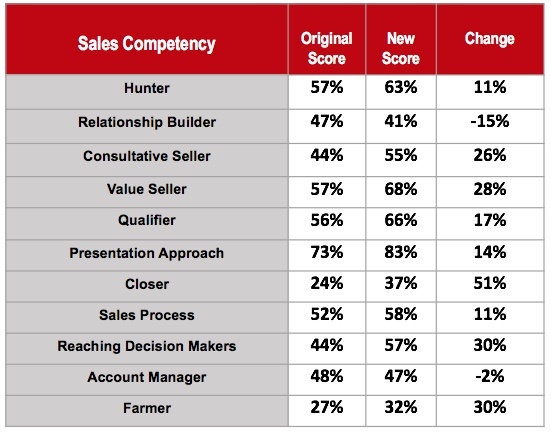- September 18, 2018
- Posted by: Dave Kurlan
- Category: Understanding the Sales Force

I’ve written extensively about how salespeople score in 21 Sales Core Competencies. Typically, both the articles and data are shared in the context of the difference between top salespeople and weak salespeople but rarely have I written about what happens after salespeople have been evaluated.
Here’s how it usually works. A company asks their outside sales expert for help growing sales. As a first step, the expert suggests evaluating the sales force using OMG’s incredible suite of tools. The results are shared and reviewed with the client and anonymous data from the evaluation is added to our nearly 1.8 million rows of data. That is the data I so often write about and you can see the aggregate scores, sorted by sales percentile, industry or region, at our public statistics site.
Post evaluation, the expert will likely help the company by providing some combination of training, coaching, consulting, recruiting, systems and processes updates in the areas that need to be improved. As a result, do salespeople actually get better? That’s a direct result of the trainer’s/consultant’s effectiveness, the company’s commitment to change, and the sales managers’ ability to coach to the sales process and methodology, all well out of OMG’s hands. However, we do have some insight into how much their salespeople improve.
Approximately one year after the initial sales force evaluation, OMG offers to conduct a checkpoint where change can be measured and now I have the data.
I looked at the before and after scores for eight of the 21 Sales Core Competencies as well as the Reaches Decision Makers, Account Manager and Farmer competencies for a total of 11. See the table below:

One of the first things you might notice is that scores went down in 2 competencies – Relationship Building and Account Management. Many salespeople believe that selling is simply having relationships and showing up. Then, when training and coaching targets the more impactful competencies, it’s not unusual to see scores actually get worse in the two competencies they previously took for granted.
Another thing you might notice is the significance of change for Closing, Reaching Decision Makers, and Selling Value, a bi-product of what I assume the training and coaching would have been focused on post evaluation.
Twelve months later, there is an overall 18% improvement in scores. We know that just a 10% improvement creates a 33% increase ins sales. Don’t believe me? Check out this table:
 If a 10% improvement creates a 33% improvement in revenue, what does an 18% improvement create? Math is a really important tool in creating value and in this case, math tell us we can expect a 59% increase in revenue.
If a 10% improvement creates a 33% improvement in revenue, what does an 18% improvement create? Math is a really important tool in creating value and in this case, math tell us we can expect a 59% increase in revenue.
Image Copyright iStock Photos
